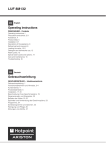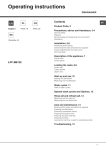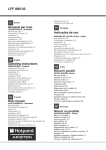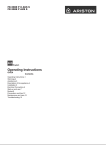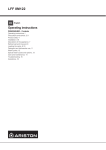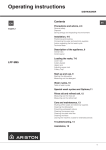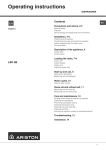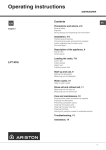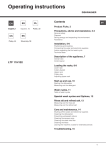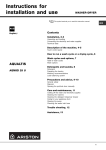Download Ariston LFF 8M132 Operating instructions
Transcript
Operating instructions DISHWASHER EN Contents EN Product Fiche, 2 English,1 Precautions and advice, 3-4 General safety Disposal Saving energy and respecting the environment Installation, 5-6 Positioning and levelling Connecting the water and electricity supplies Advice regarding the first wash cycle Technical data Description of the appliance, 7 Overall view Control panel LFF 8M132 Loading the racks, 8-9 Lower rack Cutlery basket Upper rack Tip-up compartments with adjustable position Cutlery tray* Adjusting the height of the upper rack Unsuitable crockery Damage to glass and crockery Start-up and use, 10 Starting the dishwasher Measuring out the detergent Wash cycles, 11 Table of wash cycles Special wash cycles and Options, 12 Rinse aid and refined salt, 13 Measuring out the rinse aid Measuring out the refined salt Care and maintenance, 14 Shutting off the water and electricity supplies Cleaning the dishwasher Preventing unpleasant odours Cleaning the sprayer arms Cleaning the water inlet filter Cleaning the filters Leaving the machine unused for extended periods Troubleshooting, 15 1 Product Fiche EN Product Fiche Brand ARISTON Model LFF 8M132 Rated capacity in standard place settings (1) 14 Energy Star Rating 4.0 Comparative Energy Consumption (kWh/year), CEC 220.0 Energy Total (kWh), Et 0.552 Average measured Standby Power (W), Ps 2.34 Primary Total Water Volume (L) 9.8 Water Star Rating 5.5 Noise in dB(A) Re 1pW 42 Built-in model No NOTES 1) The information on the label and fiche relates to the standard cleaning cycle, this programme is suitable to clean normally soiled tableware and it is the most efficient programme in terms of combined energy and water consumption. The standard cleaning cycle corresponds to the Normal cycle. 2 Precautions and advice This appliance was designed and manufactured in compliance with international safety standards The following information has been provided for safety reasons and should therefore be read carefully. Keep this instruction manual in a safe place for future reference. If the appliance is sold, given away or moved, please ensure the manual is kept with the machine. Please read these instructions carefully: they contain important information on installation, use and safety. This appliance is designed for domestic use or similar applications, for example: - staff kitchen areas in shops, offices and other work environments; - farmhouses; - use by guests in hotels, motels and other residential settings; - bed & breakfasts. General safety • The appliance should not be operated by people (including children) with reduced physical, sensory or mental capacities, or by inexperienced people who are not familiar with the product, unless supervision or instructions on how to use it are provided by someone who assumes responsibility for their safety. • An adult must supervise children at all times to prevent them from playing with the appliance. • The appliance was designed for domestic use inside the home and is not intended for commercial or industrial use. • The appliance must be used by adults only to wash domestic crockery in accordance with the instructions in this manual. • The appliance must not be installed outdoors, even in covered areas. It is extremely dangerous to leave the machine exposed to rain and storms. • Do not touch the appliance when barefoot. • When unplugging the appliance always pull the plug from the mains socket. Do not pull on the cable. • The water supply tap must be shut off and the plug should be removed from the electrical socket before cleaning or maintaining the appliance. • If the appliance breaks down, do not under any circumstances touch the internal parts in an attempt to perform the repair work yourself. • Do not lean or sit on the open door of the appliance: this may cause the appliance to overturn. • The door should not be left open as it may create a dangerous obstacle. • Some dishwasher detergents are strongly alkaline. They can be extremely dangerous if swallowed. Avoid contact with the skin and eyes and keep children away from the dishwasher when the door is open. Check that the detergent receptacle is empty after completion of the wash cycle. • The packaging material should not be used as a toy for children. EN Disposal • Disposal of packaging material: observe local legislation so that the packaging may be reused. • The European Directive 2012/19/EU relating to Waste Electrical and Electronic Equipment (WEEE) states that household appliances should not be disposed of using the normal solid urban waste cycle. Exhausted appliances should be collected separately in order to optimise the re-using and recycling rate of the materials inside the machine, while preventing potential damage to the environment and public health. The crossed-out dustbin symbol is marked on all products to remind the owners of their obligations regarding separated waste collection. For further information relating to the correct disposal of household appliances, owners may contact the relevant public authority or the local appliance dealer. Saving energy and respecting the environment Saving water and energy • Only begin a wash cycle when the dishwasher is full. While waiting for the dishwasher to be filled, prevent unpleasant odours using the Soak cycle (see Wash cycles). • Select a wash cycle that is suited to the type of crockery and to the soil level of the crockery using the Table of wash cycles: - for dishes with a normal soil level use the Eco wash cycle, which ensures low energy/ water consumption levels. * Only available in selected models. 3 EN - If the load is smaller than usual activate the Half Load option* (see Start-up and use). • If your electricity supply contract gives details of electricity-saving time bands, run wash cycles when electricity prices are lower. The Delayed Start button * (see Start-up and use) helps you organise the wash cycles accordingly. Phosphate-free and chlorine-free detergents containing enzymes • We strongly recommend that you use detergents that do not contain phosphates or chlorine, as these products are harmful to the environment. • Enzymes provide a particularly effective action at temperatures around 50°C. As a result detergents containing enzymes can be used in conjunction with low-temperature wash cycles in order to achieve the same results as a normal 65°C wash cycle. • To avoid wasting detergent, use the product in appropriate quantities based on the manufacturer’s recommendations, the hardness of the water, the soil level and the quantity of crockery to be washed. Even if they are biodegradable, detergents contain substances which may alter the balance of nature. 4 Installation If the appliance must be moved at any time, keep it in an upright position; if absolutely necessary, it may be tilted onto its back. Positioning and levelling 1. Remove the appliance from all packaging and check that it has not been damaged during transportation. If it has been damaged, contact the retailer and do not proceed any further with the installation process. The hose should not be bent or compressed. EN Connecting the water outlet hose Connect the outlet hose (without bending it) to a drain duct with a minimum diameter of 4 cm. The outlet hose must be at a height ranging from 40 to 80 cm from the floor / surface where the dishwasher rests (A). 2. Arrange the dishwasher so that its sides or back panel are in contact with the adjacent cabinets or the wall. This appliance can also be recessed under a single worktop* (see the Assembly Instruction sheet.) 3. Position the dishwasher on a level sturdy floor. If the floor is uneven, the front feet of the appliance should be adjusted until it reaches a horizontal position. If the appliance is levelled correctly, it will be more stable and much less likely to move or cause vibrations and noise while it is operating. 4*. To adjust the height of the rear foot, turn the red hexagonal bushing on the lower central part at the front of the dishwasher using a hexagonal spanner with an opening of 8 mm. Turn the spanner in a clockwise direction to increase the height and in an anticlockwise direction to decrease it (see Building-in Instruction sheet attached to the documentation.) Connecting the water and electricity supplies Connection to the water and electricity supplies should only be performed by a qualified technician. The dishwasher should not stand on the water hoses or electricity supply cable. The appliance must be connected to the water supply network using new hoses. Do not use old piping. Never use old or second hand hose sets. Do not reuse hose sets from any previously installed dishwasher. The water inlet and outlet hoses and the electricity supply cable may be positioned towards the right or the left in order to achieve the best possible installation. Connecting the water inlet hose • To a suitable cold water connection point: before attaching the hose, run the water until it is perfectly clear so that any impurities that may be present in the water do not clog the appliance; after performing this operation, screw the inlet hose tightly onto a tap with a ¾ gas threaded connection. • To a suitable hot water connection point: your dishwasher may be supplied with hot water from the mains supply (if you have a central heating system with radiators) provided that it does not exceed a temperature of 60°C. Screw the hose to the tap as described for connection to a cold water supply. If the inlet hose is not long enough, contact a specialist store or an authorised technician (see Assistance.) The water pressure must be within the values indicated in the Technical Data table (see adjacent information.) Before connecting the water outlet hose to the sink drain, remove the plastic plug (B). Anti-flooding protection To ensure floods do not occur, the dishwasher: - is provided with a special system which blocks the water supply in the event of anomalies or leaks from inside the appliance. Some models are also equipped with the supplementary safety device New Acqua Stop*, which guarantees anti-flooding protection even in the event of a supply hose rupture. WARNING: HAZARDOUS VOLTAGE! Under no circumstances should the water inlet hose be cut, as it contains live electrical parts. Electrical connection Before inserting the plug into the electrical socket, make sure that: • The socket is earthed and complies with current regulations. • the socket can withstand the maximum load of the appliance, which is indicated on the data plate located on the inside of the door (see Description of the appliance); • The power supply voltage falls within the values indicated on the data plate on the inside of the door. • The socket is compatible with the plug of the appliance. If this is not the case, ask an authorised technician to replace the plug (see Assistance); do not use extension cables or multiple sockets. Once the appliance has been installed, the power supply cable and the electrical socket should be easily accessible. The cable should not be bent or compressed. If the power supply cable is damaged, it must be replaced by the manufacturer or its Technical Assistance Service in order to prevent all potential hazards (see Assistance.) * Only available in selected models. 5 EN Anti-condensation strip* After installing the dishwasher, open the door and stick the adhesive transparent strip under the wooden shelf in order to protect it from any condensation which may form. Advice regarding the first wash cycle After the appliance has been installed, immediately before running the first wash cycle, completely fill the salt dispenser with water and add only then approximately 1 kg of salt (see chapter entitled Rinse aid and refined salt). The water may overflow: this is normal and is not a cause for concern. Select the water hardness value (see chapter entitled Rinse aid and refined salt). - After the salt has been poured into the machine, the LOW SALT indicator light* switches off. If the salt container is not filled, the water softener and the heating element may be damaged as a result. The machine has a buzzer/set of tones (depending on the dishwasher model) to inform the user that a command has been implemented: power on, cycle end etc. The symbols/indicator lights/LEDs on the control panel/ display may vary in colour and may have a flashing or fixed light (depending on the dishwasher model). The display provides useful information concerning the type of wash cycle, drying/wash-cycle phase, remaining time, temperature etc etc. Technical data Dimensions width 60 cm height 85 cm depth 60 cm Capacity 14 standard place-settings Water supply pressure 0,05 ÷ 1MPa (0.5 ÷ 10 bar) 7,25 – 145 psi Power supply voltage See appliance data plate Total absorbed power See appliance data plate Fuse See appliance data plate This dishwasher conforms to the following European Community Directives: -2006/95/EC (Low Voltage) -2004/108/EC (Electromagnetic Compatibility) -2009/125/EC (Comm. Reg. 1016/2010) (Ecodesign) -97/17/EC (Labelling) -2012/19/EC (WEEE) * Only available in selected models. 6 Description of the appliance Overall view EN Upper rack Upper sprayer arm Tip-up compartments Rack height adjuster Lower rack Lower sprayer arm Washing filter Salt dispenser Detergent dispenser, rinse-aid dispenser and Active Oxygen device* Data plate Control panel*** Turbo dry* 1. 2. 3. 4. 5. 6. 7. 8. 9. 10. 11. 12. Control panel Extra Drying option button Zone Wash option button Button and indicator light On-Off/Reset Multi-functional Tablets option button (Tabs) Display Start/Pause button and indicator lights Wash-Cycle Selection buttons Short time Option button Delayed Start buttons Low Salt indicator light Remaining Time indicator Washing and Drying indicator lights Blocked Filter indicator light Low Rinse-Aid indicator light Tap Shut-Off indicator light Wash-cycle indicator lights Wash-cycle indicator lights Delayed Start indicator light Short Time indicator light Zone Wash indicator lights Extra Drying indicator light Multi-Functional Tablets indicator light (Tabs) ***Only in completely built-in models. * Only available in selected models. The number and type of wash cycles and options may vary depending on the dishwasher model. 7 Loading the racks Tips EN Before loading the racks, remove all food residues from the crockery and empty liquids from glasses and containers. No preventive rinsing is needed under running water. Arrange the crockery so that it is held in place firmly and does not tip over; and arrange the containers with the openings facing downwards and the concave/convex parts placed obliquely, thus allowing the water to reach every surface and flow freely. Make sure that the lids, handles, trays and frying pans do not prevent the sprayer arms from rotating. Place any small items in the cutlery basket. Since plastic dishes and non-stick frying pans usually retain more water drops, their drying will be not so good as that of ceramic or stainless-steel dishes. Lightweight items such as plastic containers should be placed in the upper rack and arranged so that they cannot move. After loading the appliance, make sure that the sprayer arms can rotate freely. Several dishwasher models are fitted with tip-up sectors*. They can be used in a vertical position when arranging dishes or in a horizontal position (lower) to load pans and salad bowls easily. Cutlery basket It is equipped with top grilles for improved cutlery arrangement. The cutlery basket must only be positioned at the front of the lower rack. Lower rack The lower rack can hold pans, lids, dishes, salad bowls, cutlery etc. Large plates and lids should ideally be placed at the sides. Knives and other utensils with sharp edges must be placed in the cutlery basket with the points facing downwards or they must be positioned horizontally in the tip-up compartments on the upper rack Upper rack Load this rack with delicate and lightweight crockery such as glasses, cups, saucers and shallow salad bowls. Very soiled dishes and pans should be placed in the lower rack because in this sector the water sprays are stronger and allow a higher washing performance. *Only available in selected models with different numbers and positions. 8 Tip-up compartments with adjustable position The side tip-up compartments can be positioned at three different heights to optimize the arrangement of crockery inside the rack. Wine glasses can be placed safely in the tip-up compartments by inserting the stem of each glass into the corresponding slots. The upper rack can be adjusted for height based on requirements: high position to place bulky crockery in the lower rack and low position to make the most of the tip-up compartments/sectors by creating more space upwards. Adjusting the height of the upper rack In order to make it easier to arrange the crockery, the upper rack may be moved to a higher or lower position. The height of the upper rack should be adjusted WHEN THE RACK IS EMPTY. NEVER raise or lower the rack on one side only. Cutlery tray* Some dishwasher models are fitted with a sliding tray which can be used to hold serving utensils or small cups. For optimum washing performance avoid positioning bulky crockery directly below the tray. The cutlery tray can be removed (see Figure). If the rack is equipped with a Lift-Up device* (see figure), lift it up by holding its sides. To restore the lower position, press the levers (A) at the sides of the rack and follow the rack down. Unsuitable crockery • Wooden crockery and cutlery. • Delicate decorated glasses, artistic handicraft and antique crockery. Their decorations are not resistant. • Parts in synthetic material which do not withstand high temperatures. • Copper and tin crockery. • Crockery soiled with ash, wax, lubricating grease or ink. The colours of glass decorations and aluminium/silver pieces can change and fade during the washing process. Some types of glass (e.g. crystal objects) can become opaque after a number of wash cycles too. Before loading the tray, make sure the supports are properly coupled to the upper rack (see Figure). Damage to glass and crockery Caused by: • Type of glass and glass production process. • Chemical composition of detergent. • Water temperature of rinse cycle. Tips: • Only use glasses and porcelain guaranteed by the manufacturer as dishwasher safe. • Use a delicate detergent suitable for crockery. • Collect glasses and cutlery from the dishwasher as soon as the wash cycle is over. * Only available in selected models. * Only available in selected models. 9 EN Start-up and use EN Starting the dishwasher Measuring out the detergent 1. Turn the water tap on. 2. Press the ON/OFF button: The ON/OFF indicator light and the display light up. 3. Open the door and pour in a suitable amount of detergent A good wash result also depends on the correct amount of detergent being used. Exceeding the stated amount does not result in a more effective wash and increases environmental pollution. (see below). 4. Load the racks (see Loading the racks) and shut the door. 5. Select the wash cycle in accordance with the type of crockery and its soil level (see Table of wash cycles) by pressing the wash-cycle selection buttons. 6. Select the wash options* (see adjacent information). 7. Start the cycle by pressing the Start/Pause button: The wash indicator light comes on and the time left to the end of the cycle appears on the display. 8. At the end of the cycle, the display shows END. Switch off the appliance by pressing the ON/OFF button, shut off the water tap and unplug the appliance from the electricity socket. 9. Wait for a few minutes before removing the crockery in order to avoid burns. Unload the racks, beginning with the lower level. Based on how soiled the items are, the amount can be adjusted to individual cases using powder or liquid detergent. In the case of normally soiled items, use approximately either 35 gr (powder detergent) or 35 ml (liquid detergent). If tablets are used, one tablet will be enough. If the crockery is only lightly soiled or if it has been rinsed with water before being placed in the dishwasher, reduce the amount of detergent used accordingly. For good washing results also follow the instructions shown on the detergent box. For further questions please ask the detergent producers' Advice Offices. To open the detergent dispenser use the opening device “A”. - The machine will switch off automatically during long periods of inactivity in order to minimise electricity consumption. AUTO WASH CYCLES*:some dishwasher models are equipped with a special sensor which can be used to assess the level of soiling and automatically select the most efficient and economical wash cycle accordingly. The duration of the auto wash cycles may vary due to the operation of the sensor. Changing a wash cycle in progress If a mistake was made in the wash cycle selection process, it is possible to change the cycle provided that it has only just begun: once the wash cycle has started, in order to change the wash cycle switch off the machine by pressing and holding the ON/ OFF/Reset button. Switch it back on using the same button and select the desired wash cycle and options. Adding extra crockery Press the Start/Pause button and open the door, taking care to avoid the escaping steam, and place the crockery inside the dishwasher. Press the Start/Pause button: The cycle will start again after a long beep has been emitted. If the delayed start has been set, at the end of the countdown the wash cycle will not start. It will stay in Pause mode. Press the Start/Pause button to pause the machine; the wash cycle is stopped. At this stage it is not possible to change the wash cycle. Accidental interruptions If the door is opened during the wash cycle or there is a power cut, the cycle stops. It starts again from the point at which it was interrupted once the door has been shut or the electricity supply is restored. * Only available in selected models. 10 Introduce the detergent into the dry dispenser “B” only. Place the amount of detergent for pre-washing directly inside the tub. 1. When measuring out the detergent refer to the Table of wash cycles to add the proper quantity. Compartment B comprises a level showing the maximum quantity of liquid or powder detergent that can be added to each cycle. 2. Remove detergent residues from the edges of the dispenser and close the cover until it clicks. 3. Close the lid of the detergent dispenser by pulling it up until the closing device is secured in place. The detergent dispenser automatically opens up at the right time according to the wash cycle. If all-in-one detergents are used, we recommend using the TABS option, because it adjusts the cycle so that the best washing and drying results are always achieved. Only use detergent which has been specifically designed for dishwashers. DO NOT USE washing-up liquid. Using excessive detergent may result in foam residue remaining in the machine after the cycle has ended. The use of tablets is only recommended for models which offer the MULTI-FUNCTIONAL TABLETS option. To achieve the best results from each washing and drying cycle, powder detergent, liquid rinse aid and salt should be used. Wash cycles The number and type of wash cycles and options may vary depending on the dishwasher model. EN Wash cycle which include drying Options Approximate duration of wash cycles Water consumption (l/cycle) Energy consumption (KWh/cycle) 1. Normal Yes Delayed start – Tabs – Extra Dry – 02:55’ 9,8 0,55 2. Auto 65° Yes Delayed start – Tabs – Extra Dry – Short Time – Zone wash 02:00’ - 03:10’ 14,0 - 15,5 1,50 - 1,80 3. Auto 55° Yes Delayed start – Tabs – Extra Dry – Short Time – Zone wash 01:30’ - 02:30’ 14,5 – 16,0 1,20 - 1,35 4. Auto 50° No Delayed start – Tabs 00:40’ - 01:20’ 13,0 - 14,5 1,15- 1,25 5. Duo Wash Yes Delayed start – Tabs – Extra Dry – Short Time 02:00’ 18,0 1,30 6. Delicates Yes Delayed start – Tabs – Extra Dry 01:40’ 11,0 1,10 7. Express 30’ No Delayed start – Tabs 00:30’ 9,0 0,50 8. Soak No Delayed start 00:12’ 4,5 0,01 Wash cycle Instructions on wash-cycle selection and detergent dosage 1. The NORMAL wash cycle is the standard cycle to which the energy label data refers. It can be used to wash crockery with a normal soil level and is the most efficient cycle in terms of energy and water consumption for this type of crockery. Open the door at end of programme by 50mm to assist in drying. Add detergent amounts for cycle: 29 gr/ml main wash + 6 gr/ml** prewash – 1 Tab (**Quantity of pre-washing detergent) 2. Heavily soiled dishes and pans (not to be used for delicate items). 35 gr/ml – 1 Tab 3. Normally soiled pans and dishes. 29 gr/ml + 6 gr/ml** – 1 Tab 4. Limited quantity of daily soiling (ideal for 4 place settings) 25 gr/ml – 1 Tab 5. Wash spread over the two racks: delicate for crystal and glasses on the upper rack and heavy duty for the pans on the lower rack. 35 gr/ml – 1 Tab 6. Cycle for delicate items, which are more sensitive to high temperatures 35 gr/ml – 1 Tab 7. Fast cycle to be used for slightly dirty dishes (ideal for 2 place settings) 25 gr/ml – 1 Tab 8. Pre-wash while awaiting completion of the load with the dishes from the next meal. No detergent. 11 Special wash cycles and Options EN Notes: Optimum performance levels when using the “Auto 50° and Express ” cycles can be achieved by respecting the specified number of place settings. To reduce consumption even further, only run the dishwasher when it is full. * The Normal wash cycle adheres to the regulation standard AS/NZS 2007. Although it has a longer duration than other wash cycles it uses less energy and is less harmful to the environment. Extra drying To improve the dryness level of the crockery, press the EXTRA DRYING button and the symbol will light up. If it is pressed again, the option will be deselected. A higher temperature during the final rinsing and a longer drying phase improve the dryness level. The EXTRA DRYING option increases the duration of the wash cycle. Multi-functional tablets (Tabs) Note for Test Laboratories: for information relating to comparative Standard AS/NZS testing conditions, please send an email to the following address: assistenza_en_lvs@ indesitcompany.com This option optimises washing and drying results. When using multi-functional tablets, press the MULTIFUNCTIONAL TABLETS button; the corresponding symbol will light up. If the button is pressed again, the option will be deselected. Wash options* The “Multi-functional tablets” option results in a longer wash cycle. The OPTIONS may only be set, changed or reset after the wash cycle has been selected and before the Start/ Pause button has been pressed. Only the options which are compatible with the type of wash cycle set may be selected. If an option is not compatible with the selected wash cycle (see Table of wash cycles), the corresponding symbol flashes rapidly 3 times. If an option is selected which is not compatible with another (previously selected) option, it will flash 3 times and switch off, while the most recently selected option will remain active. To deselect an option which has been set by mistake, press the corresponding button again. Delayed start It is possible to delay the start time of the cycle for a period of time between 1 and 24 hours: 1. Select the desired wash cycle and any other options required, press the DELAYED START button. The relevant symbol starts flashing. Use the buttons + and - to select when the wash cycle will start (h01, h02 etc.) 2. Confirm with the START/PAUSE button. The symbol stops flashing and the countdown begins. 3. Once this time has elapsed, the DELAYED START symbol switches off and the wash cycle begins. To deselect the DELAYED START option, press the DELAYED START button until the text OFF appears. The Delayed Start function cannot be set once a wash cycle has been started. Short Time option This option can be used to reduce the duration of the main wash cycles while maintaining the same washing and drying performance levels. After selecting the wash cycle, press the Short Time option button; To deselect the option, press the same button again. 12 The use of tablets is only recommended for models having this option and it is not recommended with wash cycles which do not specify the use of multi-functional tablets. Zone Wash This option makes it possible to carry out the wash cycle in the selected rack only. Select the wash cycle and then press the ZONE WASH button: the selected rack lights up and the wash cycle starts in the selected rack only. Press the button again to deselect the option. The option is available with the following wash cycles: Intensive and Normal. Select the option and the Intensive cycle to start the ULTRAINTENSIVE ZONE washing. This wash cycle is ideal for very soiled mixed loads, e.g. pans and saucepans, dishes with heavy encrustation or difficult-to-clean crockery (grater, vegetable mill, dirty cutlery). The spraying pressure is stronger and the washing temperature higher, thus ensuring optimum handling of stubborn stains. Select the option and the Normal cycle to start the SAVING ZONE washing. This function makes it possible to reduce water and energy consumption, thus achieving excellent washing and drying results. Cycle duration is longer. Remember to load the crockery in the selected rack only Rinse aid and refined salt Only use products which have been specifically designed for dishwashers. Do not use table/industrial salt or washing-up liquid. Follow the instructions given on the packaging. If using a multi-functional product it is not necessary to add any rinse aid. However, we recommend that you add salt, especially if you live in an area where the water is hard or very hard. (Follow the instructions given on the packaging). If you do not add salt or rinse aid, the LOW SALT* and LOW RINSE AID indicator lights will stay lit. Measuring out the rinse aid Rinse aid makes it easier for the crockery to dry, as water runs off the surfaces more readily and therefore does not leave streaks or marks. The rinse aid dispenser should be filled: • When the LOW RINSE AID indicator light* on the control panel is illuminated, a reserve supply of rinse aid is still available for 1-2 cycles; MA X 1. Open the dispenser “D” by pressing and pulling up the tab on the lid; 2. Carefully introduce the rinse aid as far as the maximum reference notch of the filling space - avoid spilling it. If this happens, clean the spill immediately with a dry cloth. 3. Press the lid down until you hear a click to close it. NEVER pour the rinse aid directly into the appliance tub. Rinse-aid dispenser setting If you are not completely satisfied with the drying results, you can adjust the quantity of rinse aid. Switch on the dishwasher using the ON/OFF button, wait a few seconds and switch it off using the ON/OFF button. Press the Start/Pause button 3 times; switch on the machine using the ON/OFF button and access the adjustment menu - the rinse-aid indicator light is lit (set to factory level). Select the level of rinse aid supply using the ECO cycle button (0 to 4 max.) Press the ON/OFF button to save the setting. If the rinse aid level is set to ZERO, no rinse aid will be supplied. The LOW RINSE AID indicator light will not illuminate if you run out of rinse aid. • If there are streaks on the crockery, set the adjustment device to a lower number (1-2.) • If there are drops of water or limescale marks, set the adjustment device to a higher number (3-4.) Setting the water hardness Every dishwasher is equipped with a water softener which, by using refined salt specially designed for this type of appliance, supplies water without limescale which is then used to wash the crockery. This dishwasher offers a setting which helps to reduce pollution and optimises washing performance in accordance with the water hardness level in your area. This information can be obtained from the organisation which supplies your household with water. - Switch on the dishwasher using the ON/OFF button, wait a few seconds and switch it off using the ON/OFF button. Hold down the Start/Pause button for min. 3 seconds; switch on the machine using the ON/OFF button and access the adjustment menu - the salt indicator light is lit. - Select the desired level (1 to 5* max. based on the dishwasher model) using the ECO button. (water softener set to medium level). Press the ON/OFF button to save the setting. Even if using multi-functional tablets, the salt dispenser should still be filled. Water Hardness Table level 1 2 3 4 5* °dH 0-6 6 - 11 12 - 17 17 - 34 34 - 50 °fH 0 - 10 11 - 20 21 - 30 31 - 60 61 - 90 mmol/l 0-1 1,1 - 2 2,1 - 3 3,1 - 6 6,1 - 9 Average salt dispenser capacity duration** months 7 months 5 months 3 months 2 months 2/3 weeks For values between 0°f and 10°f, we do not recommend the use of salt. * a setting of 5 may increase cycle duration. ** 1 wash cycle per day. (°dH = hardness measured in German degrees - °f = hardness measured in French degrees – mmol/l = millimoles per litre) Measuring out the refined salt In order to obtain the best possible results from a wash cycle, make sure that the salt dispenser is never empty. Refined salt removes limescale from the water, thus avoiding the formation of deposits on crockery. The salt dispenser is located in the lower part of the dishwasher (see Description) and should be filled: • When the green float* cannot be seen by simply looking at the cap of the salt dispenser; • When the LOW RINSE AID indicator light on the control panel is illuminated *; 1. Remove the lower rack and unscrew the cap (anticlockwise). 2. The first time you do this: fill the water tank right up to its edge. 3. Position the funnel* (see figure) and fill the salt dispenser up to the edge (approximately 1 kg). It is normal for a little water to leak out. 4. Remove the funnel* and wipe any salt residues away from the opening; rinse the cap under running water and then screw it on, the head facing downwards so as to let the water flow out of the four slots (star-shaped arrangement) in the lower part of the cap (cap with green float*). It is advisable to perform this procedure every time you add salt to the dispenser. Make sure the cap is screwed on tightly so that no detergent can get into the container during the wash cycle (this could damage the water softener beyond repair). When necessary, measure out the salt before a wash cycle so that any saline solution which has leaked out of the salt dispenser is removed. * Only available in selected models. 13 EN Care and maintenance EN Shutting off the water and electricity supplies • Turn off the water tap after every wash cycle to avoid leaks. • Always unplug the appliance when cleaning it and when performing maintenance work. Cleaning the dishwasher • The external surfaces of the machine and the control panel can be cleaned using a non-abrasive cloth which has been dampened with water. Do not use solvents or abrasive products. • Any marks on the inside of the appliance may be removed using a cloth dampened with water and a little vinegar. Preventing unpleasant odours • Always keep the door of the appliance ajar in order to avoid moisture from forming and being trapped inside the machine. • Clean the seals around the door and detergent dispensers regularly using a damp sponge. This will avoid food becoming trapped in the seals, which is the main cause behind the formation of unpleasant odours. Cleaning the filters The filter assembly consists of three filters which remove food residues from the washing water and then recirculate the water. They should be cleaned if you wish to achieve the best results in every wash. Clean the filters regularly. The dishwasher should not be used without filters or if the filter is loose. • After several washes, check the filter assembly and if necessary clean it thoroughly under running water, using a non-metallic brush and following the instructions below: 1. Turn the cylindrical filter C in an anti-clockwise direction and pull it out (fig. 1). 2. Remove the cup filter B by exerting a slight pressure on the side flaps (fig. 2); 3. Slide out the stainless-steel plate filter A. (fig. 3). 4. Inspect the trap and remove any food residues. NEVER REMOVE the wash-cycle pump protection (black detail) (fig.4). Cleaning the sprayer arms Food residue may become encrusted onto the sprayer arms and block the holes used to spray the water. It is therefore recommended that you check the arms from time to time and clean them with a small non-metallic brush. The two sprayer arms may both be removed. To remove the upper sprayer arm, turn the plastic locking ring in an anti-clockwise direction. The upper sprayer arm should be replaced so that the side with the greater number of holes is facing upwards. The lower sprayer arm can be removed by pressing on the side tabs and pulling it upwards. After cleaning the filters, re-place the filter assembly and fix it in position correctly; this is essential for maintaining the efficient operation of the dishwasher. Leaving the machine unused for extended periods Cleaning the water inlet filter* If the water hoses are new or have not been used for an extended period of time, let the water run to make sure it is clear and free of impurities before performing the necessary connections. If this precaution is not taken, the water inlet could become blocked and damage the dishwasher. Clean the water inlet filter at the tap outlet regularly. - Turn off the water tap. - Unscrew the end of the water inlet hose, remove the filter and clean it carefully under running water. - Re-place the filter and screw the water hose back into position. 14 • Disconnect the appliance from the electricity supply and shut off the water tap. • Leave the door of the appliance ajar. • When you return, run a wash cycle when the dishwasher is empty. * Only available in selected models. Troubleshooting Whenever the appliance fails to work, check for a solution from the following list before calling for Assistance. Problem: Possible causes / Solutions: The dishwasher does not start or cannot be controlled. • The door won’t close. • The lock was released. Strongly push the door until a “clacking” noise is heard. No water drains from the dishwasher. • • • • The The The The The dishwasher makes excessive noise. • • The dishes are rattling against each other or against the sprayer arms. An excessive amount of foam has been produced: the detergent has not been measured out correctly or it is not suitable for use in dishwashers (see Start-up and use). The dishes and glasses are covered in a white film or limescale deposits. • • • The level of refined salt is low or the dosage setting is not suited to the hardness of the water (see Rinse aid and salt). The lid on the salt dispenser is not closed properly. The rinse aid has been used up or the dosage is too low. The dishes and glasses are streaked or have a bluish tinge. • The rinse aid dosage is too high. The crockery has not been dried properly. • • A wash cycle The rinse aid and salt). The rinse aid The crockery • • • • The dishes are not clean. • • • • • • • • • EN Switch off the appliance by pressing the ON/OFF button, switch it back on after approximately one minute and reset the cycle. The appliance has not been plugged in properly. The dishwasher door has not been shut properly. dishwasher cycle has not yet finished. water inlet hose is bent (see Installation). drain duct is blocked. filter is clogged up with food residues. without a drying cycle has been selected. has been used up or the dosage is too low (see Rinse aid dispenser setting is not suitable. is made from non-stick material or plastic. The racks are overloaded (see Loading the racks). The crockery has not been arranged properly. The sprayer arms cannot rotate freely. The wash cycle is too gentle (see Wash cycles). An excessive amount of foam has been produced: the detergent has not been measured out correctly or it is not suitable for use in dishwashers (see Start-Up and Use). The lid on the rinse aid compartment has not been shut correctly. The filter is dirty or blocked (see Care and maintenance). The refined salt level is low (see Rinse aid and salt). Switch off the appliance by pressing the ON/OFF button. Shut off the water tap to eliminate the risk of flooding and remove the plug from the electrical socket. Make sure the water inlet filter has not become blocked by impurities (see “Care and maintenance” chapter). The dishwasher does not take any water in - Tap shut-off alarm (indicator light ON/OFF flashing; H2O and tap symbol displayed; F 6 appears after a few seconds). • • • • There is no water in the mains supply. The water inlet hose is bent (see Installation). Turn on the tap and the appliance will start after a few minutes. The appliance lock has been activated because no action was taken when the beeps sounded. Switch off the appliance using the ON/OFF button, turn on the tap and switch the appliance back on after a few seconds by pressing the same button. Re-program the appliance and restart the wash cycle. Clogged filter alarm The “filter” symbol on the display will light up. • Make sure the wash cycle has ended, open the dishwasher door and clean the cup filter and stainless-steel filter (see “Care and maintenance” chapter). The “blocked filter” symbol will go off when the following cycle starts. * Only available in selected models. 15 Assistance EN 195119763.00 04/2014 pb - Xerox Fabriano Assistance Before contacting Assistance: • Check whether the problem can be resolved using the Troubleshooting guide (see Troubleshooting). • Restart the programme to check whether the problem has ceased to exist. • If the problem persists, contact the Authorised Technical Assistance Service. Never use the services of unauthorised technicians. Please have the following information to hand: • The type of malfunction. • The appliance model (Mod.). • The serial number (S/N). This information can be found on the appliance data plate (see Description of the appliance). ARISTON PRIORITY SERVICE If you are not completely satisfied with your appliance or require service call: Australia Phone: 1300 815 589 New Zealand Phone: (09) 306 1020 AUSTRALIA ARISIT PTY LIMITED 40-44 Mark Anthony Drive, Dandenong South, VIC 3175, Australia Fax: Service & Sales (03) 9768 0838 Email: [email protected] 16 GENUINE ACCESSORIES & SPARE PARTS A wide range of genuine accessories are available for your appliance call: Australia Phone: 03 9768 0888 New Zealand Phone: (09) 306 1020 NEW ZEALAND ARISIT PTY LIMITED PO Box 68-140 Newton, Auckland 1145, New Zealand Fax: (09) 302 0077 Email: [email protected]
















